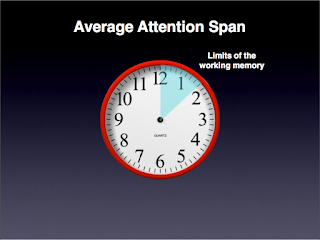 (Note: This entry will also be posted at the Experient E4 Blog)
(Note: This entry will also be posted at the Experient E4 Blog)In the Brain-Based Events Exchange Café--recently hosted at E4-- we talked about ways to engage an audience at an event and make sure that your message is communicated in a way that people will remember. Adding interaction to an event and within presentations is absolutely critical to success.
Studies cite different attention span limits (Dr. Medina stated 10 minutes), but on average, the adult attention span in a live event is from 5-7 minutes.
 That means that in most typical presentations, there is going to be a lot of attention atrophy, and the messaging will be lost. So how does one mitigate against this effect in a typical, 60-minute presentation? By adding interactive elements at regular intervals.
That means that in most typical presentations, there is going to be a lot of attention atrophy, and the messaging will be lost. So how does one mitigate against this effect in a typical, 60-minute presentation? By adding interactive elements at regular intervals.
During our exchange café, we brainstormed ways to add interaction within a presentation, and here’s what we came up with as a group:
Add a game: In our own presentation, we played a game show. In addition to being a way to review, preview and present the information in a unique way, it also added an element of energy and competition that broke up the content.
Do a skit: At an event we produced, instead of just giving the finer points of coaching, the presenter brought an assistant on stage and modeled the coaching interaction.
Have discussion: Give the audience opportunities during a presentation and an event to reflect and discuss your content with a neighbor or at their tables. Not only does it reinforce content and add interaction, but it also creates personal relevance.
Demonstrate: If it’s a new product presentation, don’t just rattle off bullet point features—have a prototype to show, or things that the audience can “play” with and interact with. If it’s a new process, actually go through the chronology.
Show a video clip: Media is a great way to break up a presentation, add emotion and captivate the audiences’ attention.
Ask questions: When a speaker interacts WITH the audience, it makes they audience accountable for their participation in the presentation. Gathering their opinions, thoughts, misconceptions, etc. makes a presentation more personally relevant.
Switch speakers: While the best-intended panels of mice and men may often go awry, the concept behind a panel or interview or tag-team speakers is a good one. Switching speakers resets the attention clock.
Use different sounds: When this was brought up in our session, it referred mostly to the modality of a person’s voice—varying tone and timbre to be a dynamic, continually engaging speaker. However, using music, sound effects, etc., could be a way to add novelty and re-engage the audience.
Add activities: An audience wants to play. Participating in hands-on activities not only increases interactivity and extends the attention span, but it also gives the opportunity to practice with key concepts and content.
Tell a joke: Humor is a wonderful way to re-engage the audience, because it evokes a strong emotional response (also causing the brain to secrete chemicals that aid in binding memory). Getting the audience to laugh is a great way to keep their attention. (This is another reason why we use live animated characters, like Ellie and Eddie the Eagles.)
Tell stories: Speaking of emotional engagement… A good story can captivate attention far beyond the typical attention span, because that’s how we’re wired to receive information, process and learn.
Dan Yaman is the Founder and CEO of Live Spark, the event design firm that produced Eddie and Ellie the eagles. Live Spark also consults on presentations and events, designs custom game and audience-response experiences and more. You can check out our blog for more tips and event insights—or check back here for more postings to come.


No comments:
Post a Comment